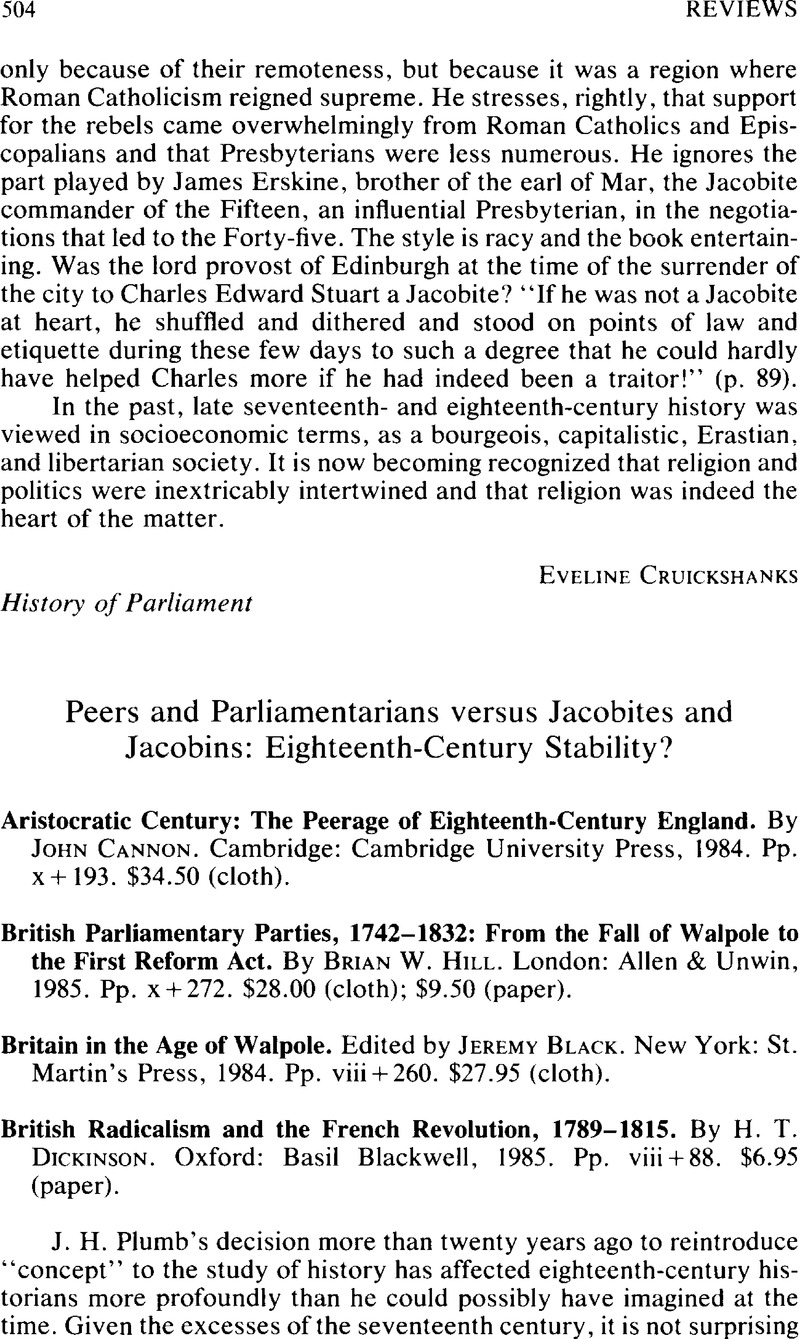No CrossRef data available.
Published online by Cambridge University Press: 10 January 2014

1 Clark, J. C. D., The Dynamics of Change (Cambridge, 1982), p. 458CrossRefGoogle Scholar.
2 Hill, B. W., The Growth of Parliamentary Parties, 1689–1742 (London, 1976)Google Scholar.
3 Christie, Ian, Stress and Stability in Late Eighteenth-Century Britain (Oxford, 1984)Google Scholar.
4 Cannon, John, “The Isthmus Repaired: The Resurgence of the English Aristocracy, 1660–1760,” Proceedings of the British Academy 68 (1982): 431–53Google Scholar.
5 Bonfleld, Lloyd, Marriage Settlements, 1601–1740 (Cambridge, 1984)Google Scholar; English, Barbara and Saville, John, “Comment on Bonfield's ‘Marriage Settlements and the “Rise of the Gentry,”’” Economic History Review 33 (1980): 556–58CrossRefGoogle Scholar.
6 Black, Jeremy, “Foreign Policy in the Age of Walpole,” in Black, Jeremy, ed., Britain in the Age of Walpole, pp. 137–38Google Scholar.
7 SirSmith, Thomas, De Republica Anglorum (London, 1583), p. 30Google Scholar.
8 Habakkuk, H. J., “England,” in The European Nobility in the Eighteenth Century, ed. Goodwin, A. (London, 1953)Google Scholar.
9 One of Northampton's seats, e.g., is listed as controlled by Earl Northampton in 1784. This ascription is defensible given the return of the earl's eldest son in each election between 1784 and 1796, but even Cannon admits the problem with counting such a populous constituency with unpredictable habits among those in the pocket of some peer.
10 Cruikshanks, Eveline, “The Political Management of Sir Robert Walpole,” in Black, , ed., p. 43Google Scholar; Cannon, John, Aristocratic Century, p. 117Google Scholar.
11 Stone, Lawrence, “The New Eighteenth Century,” New York Review of Books (March 24, 1984), p. 42Google Scholar.
12 Szechi, Daniel, Jacobitism and Tory Politics, 1710–14 (Edinburgh, 1985)Google Scholar; Bennett, G. V., The Tory Crisis in Church and State, 1688–1730 (Oxford, 1975)Google Scholar.
13 Clark, J. C. D., “The Politics of the Excluded: Tories, Jacobites and Whig Patriots, 1715–60,” Parliamentary History 2 (1983): 214–15Google Scholar.
14 Lenman, Bruce, “A Client Society: Scotland between the '15 and the '45,” in Black, , ed., p. 69Google Scholar.
15 Cockburn, Lord, Memorials of His Time (London, 1856), p. 50Google Scholar.
16 Burke, Edmund, Works (London, 1848), 5:189Google Scholar.
17 British Library, Additional MS 27,827, fol. 44.
18 Thompson, E. P., The Making of the English Working Class (London, 1968), p. 160Google Scholar.
19 Quoted in Hill, Brian W., British Parliamentary Politics, p. 174Google Scholar.
20 For the most recent statement in this continuing dispute, see Linebaugh, Peter, “(Marxist) Social History and (Conservative) Legal History: A Reply to Professor Langbein,” New York University Law Review 60 (1985): 212–43Google Scholar.